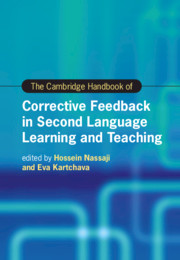Book contents
- The Cambridge Handbook of Corrective Feedback in Second Language Learning and Teaching
- Cambridge Handbooks in Language and Linguistics
- The Cambridge Handbook of Corrective Feedback in Second Language Learning and Teaching
- Copyright page
- Contents
- Figures
- Tables
- Contributors
- Acknowledgments
- Introduction Corrective Feedback in Second Language Teaching and Learning
- Part I Theoretical Perspectives on Corrective Feedback
- Part II Methodological Approaches in the Study of Corrective Feedback
- Part III Different Delivery Modes of Corrective Feedback
- Part IV Feedback Provider, Feedback Intensity, and Feedback Timing
- Part V Corrective Feedback and Language Skills
- Part VI Contexts of Corrective Feedback and Their Effects
- Part VII Learners’ and Teachers’ Feedback Perspectives, Perceptions, and Preferences
- Part VIII Individual Differences, Tasks, and Other Language- and Learner-Related Factors
- 30 Age and Corrective Feedback
- 31 Gender Effects
- 32 Feedback, Aptitude, and Multilingualism
- 33 Corrective Feedback and Affect
- 34 Corrective Feedback, Developmental Readiness, and Language Proficiency
- 35 Corrective Feedback and Grammatical Complexity: A Research Synthesis
- 36 The Role of Task in the Efficacy of Corrective Feedback
- Index
- References
30 - Age and Corrective Feedback
from Part VIII - Individual Differences, Tasks, and Other Language- and Learner-Related Factors
Published online by Cambridge University Press: 26 February 2021
- The Cambridge Handbook of Corrective Feedback in Second Language Learning and Teaching
- Cambridge Handbooks in Language and Linguistics
- The Cambridge Handbook of Corrective Feedback in Second Language Learning and Teaching
- Copyright page
- Contents
- Figures
- Tables
- Contributors
- Acknowledgments
- Introduction Corrective Feedback in Second Language Teaching and Learning
- Part I Theoretical Perspectives on Corrective Feedback
- Part II Methodological Approaches in the Study of Corrective Feedback
- Part III Different Delivery Modes of Corrective Feedback
- Part IV Feedback Provider, Feedback Intensity, and Feedback Timing
- Part V Corrective Feedback and Language Skills
- Part VI Contexts of Corrective Feedback and Their Effects
- Part VII Learners’ and Teachers’ Feedback Perspectives, Perceptions, and Preferences
- Part VIII Individual Differences, Tasks, and Other Language- and Learner-Related Factors
- 30 Age and Corrective Feedback
- 31 Gender Effects
- 32 Feedback, Aptitude, and Multilingualism
- 33 Corrective Feedback and Affect
- 34 Corrective Feedback, Developmental Readiness, and Language Proficiency
- 35 Corrective Feedback and Grammatical Complexity: A Research Synthesis
- 36 The Role of Task in the Efficacy of Corrective Feedback
- Index
- References
Summary
A question that is of central significance but has been largely ignored in the literature is whether learners of different age groups benefit from corrective feedback in different ways. This chapter seeks to discuss the theory, research, and pedagogy pertaining to the role of age in mediating the incidence and effects of corrective feedback. The chapter begins with a theoretical explanation of the relationship between age and corrective feedback. It then zeroes in on descriptive research investigating feedback provided to children by their parents or caregivers while acquiring their first language. It proceeds to discuss feedback in second language learning, summarizing descriptive research conducted in the language classroom and laboratory contexts. The effects of input-providing and output-prompting feedback from descriptive and experimental research were analyzed through the lens of participants’ ages. One pattern that emerged from the research is that output-prompting feedback leads to greater linguistic gains than input-providing feedback among child learners. The chapter concludes with implications for researchers and teachers, proposing ways to carry out research to examine the various issues surrounding the role of age through research and ways to maximize the effects of feedback for learners of different ages in the second language classroom.
- Type
- Chapter
- Information
- The Cambridge Handbook of Corrective Feedback in Second Language Learning and Teaching , pp. 645 - 667Publisher: Cambridge University PressPrint publication year: 2021

